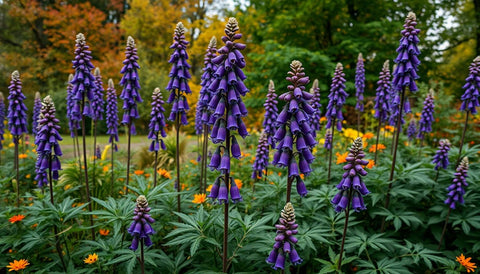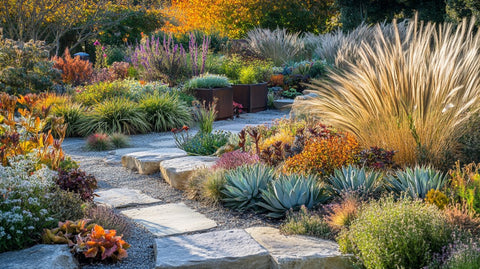Introduction
Monkshood (Aconitum) is a stunning perennial that offers late-season beauty to your garden. Fall-blooming Monkshood is perfect for adding vibrant color and interest when many other plants are starting to fade. In this post, we will guide you through the steps to plant and care for this unique and beautiful plant.

1. What is Fall-Blooming Monkshood?
Fall-blooming Monkshood is a herbaceous perennial known for its tall spikes of hooded, purple-blue flowers.
- Characteristics: Reaches heights of 3-4 feet, with dark green, deeply lobed foliage.
- Unique Features: Its distinctive helmet-like flower shape and upright growth habit make it a standout in any garden.
- Growing Zones: Hardy in USDA zones 3-7.
- Toxicity Warning: All parts of Monkshood are highly toxic if ingested, and it should be handled with gloves.
2. Choosing the Right Location
- Sunlight Requirements: Prefers partial shade, though it can tolerate full sun in cooler climates.
- Soil Preferences: Requires well-drained, organically rich soil with a slightly acidic to neutral pH.
- Spacing: Space plants 12-18 inches apart to allow good air circulation.
3. Planting Monkshood
Follow these steps to plant your Monkshood successfully:
- Choosing Plants: Select healthy plants or seeds from a reputable source.
- Optimal Planting Time: Plant in early spring or early fall for best results.
- Planting Guide:
- Prepare the soil by adding organic compost.
- Plant at the same depth as the container and space them adequately.
- Water thoroughly after planting.
- Add mulch to retain moisture and reduce weeds.
4. Caring for Your Monkshood
- Watering: Water regularly to keep the soil evenly moist, especially during dry periods.
- Fertilizing: Use a balanced, slow-release fertilizer in the spring to promote healthy growth.
- Pruning and Deadheading: Prune in late winter or early spring, and deadhead spent flowers to encourage prolonged blooming.
5. Managing Pests and Diseases
Monkshood is relatively pest-resistant but can be affected by slugs, aphids, and fungal diseases like powdery mildew. To keep your plants healthy:
- Pest Control: Use organic solutions like insecticidal soap for aphids, and slug traps to deter slugs.
- Disease Prevention: Ensure good air circulation and avoid overhead watering to prevent fungal issues.
6. Harvesting and Using Monkshood
Although toxic, Monkshood can be cut and used in decorative floral arrangements. Exercise caution when cutting flowers:
- Use gloves to handle the plant.
- Place cut stems in water immediately after cutting.
7. Conclusion
Fall-blooming Monkshood is a fantastic addition to any garden, providing late-season color and interest. With proper care and attention, it will thrive in your landscape for years to come. Have you had experience growing Monkshood? Share your thoughts and tips in the comments below!
































Comments (0)
There are no comments for this article. Be the first one to leave a message!